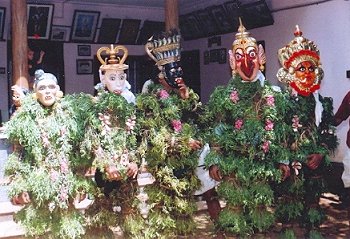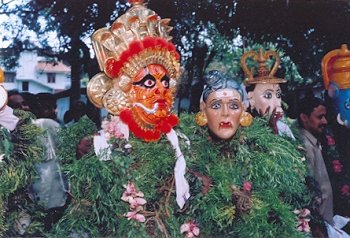
|
 |

|
 |
The Kummaatti, a colourful pageant - Padma Jayaraj, Thrissur e-mail: padmajayaraj@gmail.com August 7, 2009  The beginnings of theatre in ancient India date back to Vedic rituals, which started the classical strain. The beginnings of folk theatre, is perhaps the hunt. Drama began as mime. The first drama mimed the hunt, a magical rehearsal. Then the rehearsal became the ceremony, performed to the refrain of a song or prayer to a god. The mime of dance-drama became drama that enacted episodes from the epics: about gods, demons, kings, and humans. In Indian villages, for thousands of years, the drama whether of the hunt dance, or harvest dance or mime of plants swaying, or birds singing, remained a mixture of dance, song, and story. The difference between the folk and the classical is only a difference of degree, in refinement, in organisation of ideas and presentation. The history of folk theatre does not speak of indigenous theatre traditions in rural areas of Kerala. Kummaatti is a street performance known only to Thrissur during the season of Onam, Kerala's national festival. The sprinting Kummaatti, take you to the beginning of its cultural history. Here are masked dancers flowing from streets followed by jubilant children enjoying their Onam vacation. Perhaps, one day these children will know how they participated in the beginnings of theatre in this pageant that would paint their childhood memories in vibrant colours. Onam, a harvest festival Kerala, on the south western coast of the Indian subcontinent, is cut off by the Western Ghats from the mainland. Blessed with plentiful rains, an agrarian community grew up here with its own cultural expressions. The festivals of the mainland never penetrated the rainforests of the Ghat. Hence the festivals of Kerala are its own: agricultural in character, rich in native legends. Onam is basically a harvest festival, after its first crop of the year, after a period of torrential rains. This is the season of flowers, flowers swaying amidst sun and showers. Onam festival lasts normally for ten days. Each region has its own revelry as part of the celebrations. If boat race is part of the region of backwaters, Thrissur boasts of its street shows. Here Onam fever lasts longer. The dance of the Kummaatti and that of the 'Tigers' is exclusive to Thrissur. Wearing masks, draping grass over their shoulders, Kummaatti visit houses, followed by clapping children. "Here comes the Kummaatti There, he is at the gate..."  The song has a rhythmic beat that orchestrates with the clapping and sprinting. They flock the streets. "It's a kind of street dance and the enthusiasm that the revellers generate is contagious," says G Venu of Natanakairali. Masks have a special place in the art forms of Kerala. The masks reflect a rich theatre tradition. They provide an other-worldly dimension to the players. Anyone with a spring in his step can be a Kummaatti. And the costumes used are culled from nature: kummaatti pullu, a grass with medicinal properties; masks from plantain stem. The special fragrance of the grass donned by the players help them carry on for hours on end. Legend says that Lord Siva residing in Vadakkunathan temple asked his genies, Bhuthas, accompanying spirits to perform a dance to honour Mahabali, the banished king of Kerala, on his annual visit. Many of the masks that are on parade are Ganapathy, Kiratha, Kumbhodara and other Bhuthas. Changes Changing times have affected these voyagers in time, affected the costume and even the characters. Plastic and paper are increasingly used. Mythical characters colour the pageant. Satirical characters like the Thalla, the senile old woman, the drunkard etc give a social aspect to Kummaatti now. Kerala's own percussion instrument the chenda, is an integral part of the show now. Floats have become a fashion as different groups enter into a competitive mood. Pulikkali, the dance of the tigers, is the grand finale of Onam celebrations in Thrissur. This folk dance is a highly disciplined one moving to the beats of the dynamic chenda. Painted tigers pay tribute to the tigers that once inhabited the region before humans and their rulers built their houses and palaces. Some consider it the remnants of wars fought, wars lost and won. The speciality of the street pageant is that it is a people's festival in which all communities take part irrespective of their religion. It is a spectacle to watch as groups from different localities parade their floats surrounded by the masked, painted tigers dancing in frenzy. It is a social event sans gods and goddesses, and elephants. And tradition continues as these voyagers in time fare forward in unrecorded history. Padma Jayaraj is a freelance writer and a regular contributor to narthaki.com |